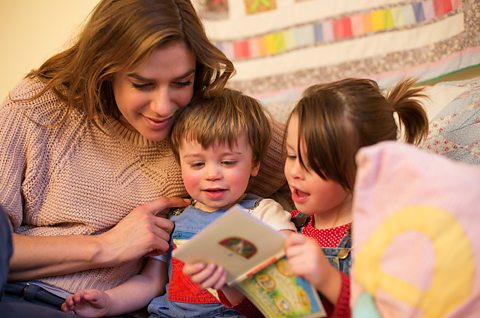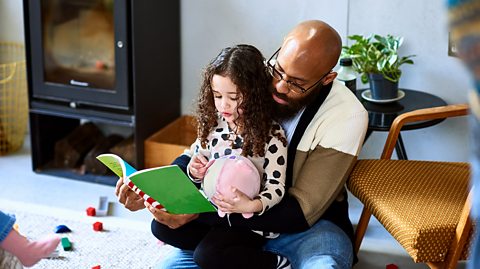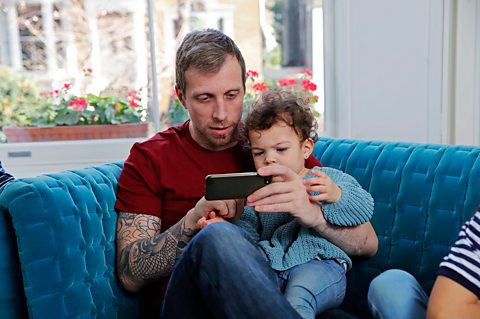Sign up to the BBC Bitesize newsletter! External LinkSign up to the BBC Bitesize newsletter!
For home education news and stories plus updates on the latest Bitesize content, register for our newsletter today.

There are so many fun ways for children to learn literacy from ages five to 11, plus English language and literature from ages 11 to 16.
English and literacy come into almost any kind of home learning you’ll do, and can incorporate a mixture of interactive and independent learning, depending on what you and your child feel like doing.
It also doesn’t matter if you’re not a big ‘reader’ yourself, or you don’t know where to start with phonics!
How do I teach reading and writing at home?
Before you begin, make sure you’ve got a variety of books and reading materials at home, as well as some paper, pencils and pens:
Alphabet books
Songs, rhymes and poems, including rhyming stories
Traditional tales, fairy tales, myths and legends
Picture books, for children of all ages
Comics and graphic novels
Short stories and longer novels
Magazines and newspapers
Maps and atlases
Recipes and instructions
Audiobooks
You don’t need to buy all the above, you can get them at your local library, access books online and as eBooks, or buy them cheaply from second-hand and charity shops.
Charity BookTrust has book recommendations for each age, charity The Reading Agency has book discussion ideas, and Centre for Literacy in Primary Education (CLPE) librarian’s blog regularly features new children’s book recommendations.

How do I teach literacy to children aged 5-11?
How to teach phonics
Charlotte Hacking is Learning and Programme Director at charity CLPE. She says: “Setting the foundations for success in phonics by reading to and with your child, talking to them and playing with them is the most important thing you can do. Encourage active listening – when you’re talking together, listen to sounds in the environment and describe them, listen to music and describe the sounds heard.”
Use our BBC Bitesize phonics resources to help you. The Children’s Literacy Charity also has a downloadable activity booklet called 'Getting Ready For Reading, Writing and Spelling.'
Use these ideas for incorporating phonics learning into everyday activities and reading:
Sing songs, read poems and rhymes; identify and think of words that rhyme
Discuss words and how they’re spelt
Listen and look for words that start with the same sound, known as alliteration, eg: ball, big, banana
Look at letters and the sounds, known as phonemes, they most commonly represent: both single letters, eg: /c/, /b/, /w/, digraphs where two letters represent one sound, eg: /sh/, /ng/, /ai/, /or/, and trigraphs where three letters represent one sound, eg: /igh/, /air/, /dge/
Spot common patterns for sounds in words and share how to segment and blend words like c-a-t, sh-o-p, etc.
For words that can be more challenging to read because they don’t follow common patterns, think about:
Groups of words where a letter or letters represent the same sound, eg: the ‘e’ in me, we, she, he, be
Common letter strings, eg: ‘oul’ in would, should, could
Common suffixes, eg: -ed, -ing, -est in words such as played, singing, biggest
Common prefixes, eg: mis-, un-, dis-, re-
Compound words, eg: whiteboard, toothbrush, playground
Words within words, eg: recognising ‘all’ in ball, called, hallway
Explore rhyme strings, eg: recognising the ‘ake’ in cake, which can also help us read or spell bake, make and mistake.

How to teach reading
Charity National Literacy Trust has ideas for sharing stories together and other reading activities. Bookmark Reading Charity also has resources you can download to use alongside reading at home.
Charlotte Hacking says: “Allow children to be in control of the reading, picking books they want you to read or share together or to read for themselves. Try not to be too judgemental about what they read."
She adds: “Find books they can relate to, for example which contain characters that look like them, that share their experiences and interests, or books that link to their interests, hobbies and passions.”
She also recommends reading aloud to your child, no matter what age they are. “This is one of the most important things you can do for your children’s developing literacy.”
Your child can listen to stories through audiobooks such as CBeebies Bedtime Stories or watch TV programmes inspired by books together, such as Nikhil and Jay for younger readers and A Kind of Spark for older readers.
Listen to your child reading to you and ensure they, “can find the meaning in what’s been read”. Discuss new words, what they mean, what they look like and patterns between them.
Read yourself, whether it’s newspapers, magazines, cookery books, looking up information, fiction or audiobooks: “Highlighting reading as an important and beneficial activity in your own life allows your children to see how important this is for their own lives.”
10 further tips to encourage reading and writing at home
Literacy develops your child’s concentration, stamina, critical and creative thinking, imagination, oracy, language, narrative ideas, vocabulary and comprehension, among other things!
Charlotte recommends encouraging literacy through fun and interactive experiences, “that are a natural part of everyday routines”. Many of these apply to your child at any age.
- Re-read and retell favourite stories, pass down stories or make up your own
- Make, draw or write plans in advance, including shopping and birthday lists, or reading instructions
- Encourage your child to draw and write their own stories, ideas, poetry, diaries, etc. to help them explore and communicate ideas, alongside doing other art and drawing activities
- Take part in team sports
- Cook and follow recipes
- Garden, birdwatch and study nature
- Play board games and video games such as Animal Crossing, Knights and Bikes, Rainbow Billy: The Curse of the Leviathan, or one of the many Bitesize games like Rhymeville, Karate Cats English, Small Town Superheroes or Crystal Explorers
- Watch and talk about TV shows together, including characters, their behaviours, actions and motivations, plots and links between parts of the narrative
- Watch poetry being performed by poets online or in person
- Go to the shops, park, city centres, wildlife or national parks, the countryside or seaside, galleries, museums, cinema, theatre, music events, book events or festivals – anything that teaches your child about the world around them. Talk about your day and things you’ve done together.

How do I teach English to children aged 11-16?
How to encourage reading and writing at home
“Spoken language continues to underpin the development of pupils’ reading and writing during Key Stage 3.” – National Curriculum for England
English teacher Ruzia Mahmud emphasises the importance of communicating with your child, and asking inquisitive questions, even when they’re older.
Empathy is important when learning English: ”When analysing a text, it’s important for students to comment on what the reader's response would be – this would be much easier to comment on if we empathise with a character or an author.”
You can enhance your child’s empathy by encouraging them to read a mix of fact and fiction.
Fun reading and writing activities
Ruzia says there are ways to embed learning from reading and writing activities:
- Talk to your child about their reading and show an interest while you’re making lunch or doing the school drop-off. Treat them to the movie version of the book after they’ve read it.
- Encourage your child to use a dictionary and thesaurus to learn and reference words they don’t know.
- Help your child create a visual image in their mind by linking pictures and images to a key event in the text.
- Create a storyboard for a plot and key events, to consolidate information.
- Once your child has read a book, ask them to write a review persuading you or their siblings to read it. This will help encourage your child to do it again.
Ruzia also suggests using a 'role on the wall' exercise to support your child's understanding of characters:
“Draw an outline of your child on large paper or print a smaller one out, then on the outside of the figure write down all the appearances and actions that the character may carry out. On the inside, write down all the emotions and feelings they may be having - linking to the text and scenario."
Then, once completed, "ask your child to write a diary entry using the emotions and feelings to consolidate their learning of the character."

How to encourage reading comprehension
Ruzia recommends getting your child moving around the room, instead of sitting at a desk. Chop up a text or snip it into chunks, enlarge it on different pieces of paper and send your child on a treasure hunt around your home.
“Give your child a comprehension question - they must hunt for the answer and bring it back, reading it carefully and writing key information down. Once completed, to truly identify whether your child has understood the information, try a short true or false quiz - this takes minimal planning!”
For more support on reading comprehension, take inspiration from the BBC Bitesize guides to critical reading and fiction writing.
How to encourage creative writing
Ruzia suggests using a visual stimulus as a prompt: “Find a genre that your child may be interested in, eg: Gothic, crime, etc. Find an enticing image from the internet and give them a few minutes to investigate it. Get them to think about the setting, atmosphere, the genre, characterisation, etc."
She adds: "They could write descriptive words and phrases to help them get a word bank together. Structuring writing is key, so perhaps start off with describing the setting and the atmosphere that’s created in the image. Using their imagination and drawing on reading and exposure to the genre will help massively!”
Or: “Give your child the first sentence to a story. Where will it take them?”
Where can I find more support for home education and parenting?
The BBC Bitesize home education collection is designed to support you and your child’s learning at home with free resources for early years and foundation stage (EYFS), primary and secondary-age students.
Bitesize Parents’ Toolkit is the go-to place for the whole parenting community to find stories, expert advice and fun activities.
If your child has special educational needs and / or disabilities, be sure to check out the Parents’ Toolkit SEND collection. Bitesize also has a collection of Sensory Stories, an immersive video series that transports you on unique sensory adventures, for children with additional or complex needs.
For more information about home education, these BBC News articles cover the rise in families deciding to educate their children at home and, from 2021, the impact of Covid on home education.